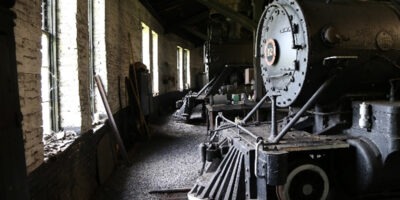Program: Extant & Bygone Roundhouses

Extant & Bygone Roundhouses
HISTORY
Richard Shulby created the Historic Railway Structures Survey (HRSS) in 1990 for the National Railway Historical Society to promote the documentation of historically significant railway structures and properties. As an unofficial volunteer extension of the National Park Service’s Historic American Buildings Survey (HABS) and Historic American Engineering Record (HAER), the HRSS provides assistance and guidance to NRHS chapters wishing to participate in the documentation process.
HRSS Extant Roundhouse Survey
The HRSS Extant Roundhouse Survey was first introduced in 1998 in response to an inquiry from the late Jim Wrinn (Editor, TRAINS magazine), who was involved with the North Carolina Transportation Museum at Spencer, NC, and wanted to know if the Southern RY roundhouse at the museum was the largest remaining example of this unique type of building. The survey lists 293 properties in the U.S., of which 191 remain in some usable form as of the 2025 update.
EXTANT Roundhouse Survey (.xlsx file)
EXTANT Roundhouse Survey (.pdf file)
EXTANT Roundhouse Online Database
HRSS Bygone Roundhouse Survey
The HRSS Bygone Roundhouse Survey, released in 2023, is an adjunct to the Extant survey and lists all the currently identified roundhouses beyond those in the Extant listing that existed previously in the U.S. from 1840. This generally includes replacement roundhouses on the same site as separate listings.
BYGONE Roundhouse Survey (.xlsx file)
BYGONE Roundhouse Survey (.pdf file)
BYGONE Roundhouse Online Database
CLARIFICATIONS
There are several definitions of what constitutes a “roundhouse.” I have chosen to limit that definition to a condition essentially unique to providing a building for servicing locomotives and rail cars via a turntable. The HRSS surveys are limited to those buildings that have the tracks arranged radially around a central point – generally the turntable or potential for a future turntable. Buildings with parallel tracks within are generally referred to as engine houses and are not included here. The buildings were generally circular in nature and could be segmented with short sections of straight walls. Some early roundhouses also enclosed their turntables as well. Shapes of the buildings did vary, generally due to site constraints or as a result of having auxiliary spaces beyond the service trackage.
LINKS
These surveys were collected through a variety of means, including Sanborn insurance maps (available through the Library of Congress website, Sanborn Fire Insurance Maps (G&M Reading Room, Library of Congress)), Historic Map Works, Historic Aerials, USGS Historical Topographic Maps, and other listings and websites. Of particular note in the creation of this compilation is the assistance from the following sources and their creators:
- All USA Roundhouses in Google Earth KMZ File (created by Brian Berthold, requires Google Earth Pro)
- Surviving Roundhouses and Turntables at steamlocomotive.com
- Stables of the Iron Horse – A Definitive History of the American Roundhouse 2022 at tim-starr-books.com
- Significant Extant Railroad Structures at Railroad Station Historical Society, Inc.
